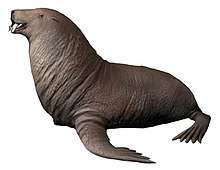Steller sea lion
The Steller sea lion (Eumetopias jubatus), also known as the Steller's sea lion and "northern sea lion", is a near-threatened species of sea lion in the northern Pacific. It is the sole member of the genus Eumetopias and the largest of the eared seals (Otariidae). Among pinnipeds, it is inferior in size only to the walrus and the two species of elephant seals. The species is named for the naturalist Georg Wilhelm Steller, who first described them in 1741. The Steller sea lion has attracted considerable attention in recent decades, owing to significant and largely unexplained declines in their numbers over an extensive portion of their northern range in Alaska.
| Steller sea lion | |
|---|---|
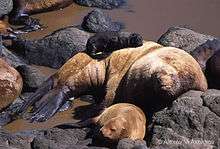 | |
| Adult male, female and pup on Yamsky Islands in the northeast Sea of Okhotsk | |
| Scientific classification | |
| Kingdom: | Animalia |
| Phylum: | Chordata |
| Class: | Mammalia |
| Order: | Carnivora |
| Clade: | Pinnipediformes |
| Clade: | Pinnipedia |
| Family: | Otariidae |
| Genus: | Eumetopias Gill, 1866 |
| Species: | E. jubatus |
| Binomial name | |
| Eumetopias jubatus Schreber, 1776 | |
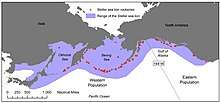 | |
| Range of Steller sea lions (purple = overall range, red = breeding rookeries) | |
Description

Adult animals are lighter in color than most sea lions, ranging from pale yellow to tawny and occasionally reddish. Steller sea lion pups are born almost black, weighing around 23 kg (51 lb), and remain dark in coloration for several months. Females and males both grow rapidly until the fifth year, after which female growth slows considerably. Adult females measure 2.3–2.9 m (7.5–9.5 ft) in length, on average being 2.5 m (8.2 ft), and weigh 240–350 kg (530–770 lb), with an average of 263 kg (580 lb).[2][3] Males continue to grow until their secondary sexual traits appear in their fifth to eighth year. Males are slightly longer than the females, growing to about 2.82–3.25 m (9.3–10.7 ft) long and averaging 3 m (9.8 ft) in length.[4] Males have much wider chests, necks, and general forebody structure. Males can weigh between 450–1,120 kg (990–2,470 lb), weighing on average 544 kg (1,199 lb).[5][6][7] Males are further distinguished from females by broader and higher foreheads, flatter snouts, and a thick mane of coarse hair[8] around their large necks. It is fitting then that their Latin name translates roughly as "maned one with the broad forehead".
Range
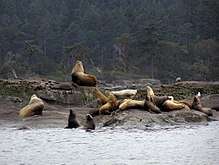
The range of the Steller sea lion extends from the Kuril Islands in the Sea of Okhotsk in Russia to the Gulf of Alaska in the north, down to Año Nuevo Island off the coast of central California to the south. They formerly bred as far south as the Channel Islands, but have not been observed there since the 1980s. Based on genetic anаlyses and local migration patterns, the global Steller sea lion population has traditionally been divided into an eastern and western stock at 144°W longitude, roughly through the middle of the Gulf of Alaska.[9][10] Recent evidence suggests the sea lions in Russia in the Sea of Okhotsk and the Kuril Islands comprise a third Asian stock, while the sea lions on the eastern seaboard of Kamchatka and the Commander Islands belong to the western stock.
In the summer, Steller sea lions tend to shift their range somewhat southward. Therefore, though there are no reproductive rookeries in Japan, several consistent haul-out sites are found around Hokkaidō in the winter and spring. Vagrants have been spotted in the Yellow Sea and Bohai Gulf and along the coast of Korea and China.[1][11]
Ecology
Habitat
Steller sea lions tend to live in the coastal waters of the subarctic because of the cooler temperate climate of the area.[12] Like all otariids, Steller sea lions are amphibious and spend some time in water and some on land.[13] Typically, Stellar sea lions spend their time in the water feeding but haul-out onto land to reproduce, raise their pups, molt, and rest.[14] Steller sea lions usually congregate on isolated islands because they are the ideal terrestrial habitat. These isolated islands are preferred by Stellar sea lions because they can avoid predation from terrestrial predators, easily thermoregulate (by means of cooling winds), and access offshore prey more easily.[13] Some haul-out sites, known as rookeries, are commonly used for reproduction while other haul-out sites are used for other purposes like molting.[15] However, both biotic and abiotic factors can influence the amount of time that Steller sea lions spend on land. Haul-out sites and haul-out abundance of the Steller sea lion can be determined by prey availability, predator abundance, tide levels, weather, etc.[15]
Foraging
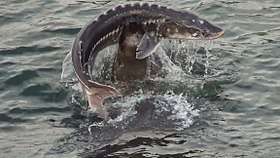
Steller sea lions are skilled and opportunistic marine predators, feeding on a wide range of fish and cephalopod species. Important diet components include walleye pollock,[16][17] Atka mackerel,[16] halibut,[17] herring, capelin,[18] flatfish[18][19] Pacific cod,[16][17] rockfish,[18][19] sculpins,[18] salmon, sand lance, and cephalopods such as various squid and octopus.[16] They seem to prefer schooling fish and forage primarily between intertidal zones and continental shelves. They usually aggregate in groups of up to twelve in areas of prey abundance. They are known to aggregate near fishing vessels, preying on bycatch discards. Most of the data on their foraging comes from data collected off the coast of Alaska; little is known of their foraging behavior elsewhere.
The composition of the diet of Steller sea lions varies seasonally and geographically; as opportunistic predators, they concentrate on the locally most abundant prey species.[20] In addition to their primary marine environment, they sometimes enter estuaries and feed on brackish-water fish such as sturgeon. Very occasionally, they have been known to prey on northern fur seals, harbor seals, and sea otter pups. Records suggest that the range of their prey species has broadened over time.[1]
Predation
Steller sea lions are top-tier carnivores, but are susceptible to predation, primarily by killer whales. Shark species are also possible predators: sleepers and great whites may prey on juvenile sea lions.[1]
Behavior and life history
Reproduction
.jpg)
Reproductively mature male sea lions gather together mid-spring on traditional, well-defined reproductive rookeries,[21][22] usually on beaches on isolated islands. The larger, older males establish and defend distinct territories on the rookery.[21][22] A week or so later, adult females arrive, accompanied occasionally by sexually immature offspring, and form fluid aggregations throughout the rookery. Like all other otariids, Steller sea lions are polygynous. However, unlike some other species, they do not coerce individual females into harems, but control spatial territories among which females freely move about.[21] Steller sea lions have used aquatic, semiaquatic, and terrestrial territories. Males with semiaquatic territories have the most success in defending them.[22] The boundaries are defined by natural features, such as rocks, faults, or ridges in rocks, and territories can remain stable for 60 days.[21] Though Steller sea lion males are generally tolerant of pups, one male filmed on Medny Island in Russia was documented killing and eating several pups in a first-ever recorded incident of cannibalism. Though researchers are uncertain as to the motives or reasons behind said attacks, it is suggested that the bull involved may have an abnormal personality akin to being psychotic.[23]
Pregnant females give birth soon after arriving on a rookery, and copulation generally occurs one to two weeks after giving birth,[21][22] but the fertilized egg does not become implanted in the uterus until the fall. A fertilized egg may remain inside a female for up to three months before being implanted and beginning to form into a blastocyst.[24] Twins are rare.[25] After a week or so of nursing without leaving the rookery, females begin to take progressively longer and more frequent foraging trips leaving their pups behind until at some point in late summer when both the mother and pup leave the rookery together. This behavior is called the maternal attendance pattern and is common in otariids. As pups get older the amount of time spent by females foraging out at sea increases.This continues until pups obtain the ideal body weight and energy reserves in order to eat on their own. A study conducted by the University of California, Santa Cruz found that on average male pups consume more milk than females. This may be due to the differences in sexual dimorphism common to otariids.[26] Reproductive males fast throughout the reproductive season,[27] often without entering the water once from mid-May until August, when the structure of the reproductive rookeries begins to fall apart and most animals leave for the open seas and disperse throughout their range.
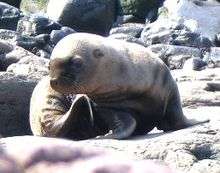
The age at weaning is highly variable; pups may remain with their mothers for as long as four years. Incidents of mothers feeding daughters that are simultaneously feeding their own newborn pups have been documented, though is an extremely rare occurrence among mammals. A study done at Ano Nuevo in 1983 found that female attendance and time spent with their pup was shaped by increasing nutritional demands of the pup and the pups suckling efficiency. Females average having 21 hours ashore and 36 hours at sea. As the pups aged, females began to spend more time at sea again. As the pups mature, specifically at the sixth week past parturition, the mother's sea time declines by 30 percent. There is no relationship between the pups' activity, or physical excursion to their suckling time, age, or sex. Their suckling time, and age and gender are unrelated to their use of energy. Labeled water studies showed that the pups' milk intake had a direct relationship to their size. Pups that consumed more milk were heavier than those that didn't. These findings show that the amount of time females spend onshore with their pups is based on their pup's suckling efficiency and nutritional demands, their metabolic needs.[28]
In the past, the low pup production has been tied to an increase in nutritional stress found in females. This was believed to have contributed to the decline in Steller sea lions common to Alaska.[24]
Locomotion
Though the largest of the eared seals, Steller sea lions are quick swimmers, with a higher swim velocity than the smaller California sea lions. Glide velocity of individual Steller sea lions has been measured as 2.9–3.4 meters or 1.2–1.5 body lengths per second, which is close to the optimal swim velocity of 1.4 body lengths per second based on the minimum cost of transport for California sea lions.[29]
A 2007 study of Steller sea lions found that a majority of thrust was produced during the drive phase of the fore flipper stroke cycle. Although previous findings on eared seals suggested that thrust was generated by the initial outward movement of the foreflippers or the terminal drag-based paddling phase, the 2007 study found that little or no thrust was generated during those phases. Swimming performance in sea lions is modulated by changes in the duration and intensity of movements without changing their sequence. Using criteria based on velocity and the minimum radius of turns, Steller's maneuverability is similar to other eared seals, superior to cetaceans, and inferior to many fish.[30]
Diving

In order to be able to dive for a long period of time, Steller sea lions exhibit apnea, bradycardia, and peripheral vasoconstriction. This allows them to maximize their oxygen stores and efficiently forage during their dives. In addition to those adaptations, their thick blubber layer and outer fur layer keep their body insulated during dives.[31]
Trained Steller sea lions from Vancouver Aquarium were placed in the open ocean at the University of British Columbia's Open Water Research Station to study their diving metabolism and behavior.[32] Steller sea lions' dives are more energetically costly if they perform dive bouts. The aerobic diving limit (ADL) of Steller sea lions was observed to be affected by their nutritional state and feeding.[33]
Communication
Like most otariids, Steller sea lions are vocal in air. Mature male sea lions have a range of vocalizations as part of their territorial behaviors, including belches, growls, snorts, and hisses that serve as warnings to others. Both males and females also produce underwater noises similar to their above water sounds, described as clicks, barks, and belches.[34] The primary function of their vocalizations is for social behavior. Sonogram readings reported that Steller Sea Lions make discrete, low frequency pulses underwater that resemble the male "belching" territoral noise made in air. These underwater vocalizations have an average of 20–30 pulses per second.[35]
Vocalizations are critical to mother-pup pairs, as the mothers must find their pups in a crowded breeding area when they return from foraging. The mother and pup both use distinctive calls, like names, to help differentiate themselves among the crowd of other sea lions.[36] Their aerial vocalizations have been described as similar to the bleats of sheep, and bellows.
Because Steller sea lions are sexually dimorphic in size, their hearing differs in sensitivity, possibly due to differences in size of the hearing structures. Females have a higher sensitivity than males, perhaps to hear the higher frequency calls of their pups. The Steller sea lion's hearing range also suggests that they are capable of hearing the underwater calls of one of their main predators, the killer whale.[37]
Interactions with humans
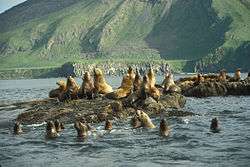
Steller sea lion were hunted for meat and other commodities by prehistoric communities everywhere their range intersected with human communities. Aside from food and clothing, their skin was used to cover baidarkas and kayaks. A subsistence harvest on the order of 300 animals or less continues to this day in some native communities in Alaska.[1]
Historically, the sea lion has had only very slight commercial value. For example, in the 19th century their whiskers sold for a penny apiece for use as tobacco-pipe cleaners.[38]
Steller sea lions are sometimes killed intentionally by fishermen, as they are seen as competitors and a threat to fish stocks.[1] Killing sea lions is strictly prohibited in the US and Russia, but in Japan a fixed number are still removed annually, ostensibly to protect their fisheries. In Canada, commercial hunting is prohibited, but limited hunting permits are occasionally granted if local culling is required—for example, nuisance animals destroying fish farms.
In recent years, Steller sea lions have been known to enter the Columbia River estuary and feed on white sturgeon, several salmon species, and rainbow trout, some of which are also listed under the U.S. Endangered Species Act. They are found in the Columbia River nearly year round,[39] with the exception of early summer, going as far upstream as Bonneville Dam.[40] Though not as abundant as the California sea lion, they are still a concern for those agencies charged with managing the fish populations. Since the Steller sea lions are themselves protected under the Marine Mammal Protection Act,[1] managers are compelled to use nonlethal deterrence methods, such as rubber bullets and noisemakers. Deterrence by the public is strictly forbidden.
Recent decline and subsequent recovery
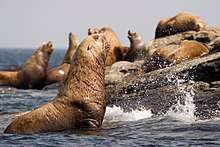
While the populations of the eastern and Asian stocks appear stable, the population of the western stock, particularly along the Aleutian Islands, was estimated to have fallen by 70–80% since the 1970s. As a consequence, in 1997 the western stock of Steller sea lions was listed as endangered and the eastern stock was listed as threatened under the United States Endangered Species Act.[41][42] They have since been the object of intense study and the focus of much political and scientific debate in Alaska.
One suspected cause of their precipitous decline was the overfishing of Alaska pollock, herring, and other fish stocks in the Gulf of Alaska. This stems largely from the "junk-food hypothesis" representing a shift in their diet from fatty herring and capelin to leaner fare such as pollock and flounder, thereby limiting their ability to consume and store fat.[43] Other hypotheses include increased predation by orcas[44] and sharks,[45] indirect effects of prey species composition shifts due to changes in climate, effects of disease or contaminants, shooting by fishermen, and others. The decline is certainly due to a complex of interrelated factors which have yet to be defined by the research effort.[46][47]
Another possible reason for decline in this species has been tied to the Nutritional Stress Hypothesis. The lack of prey corresponds to the decrease in population. In females specifically, obtaining an insufficient amount of nutrients has resulted in the failure to complete their pregnancies to full term.[48]
In October 2013, the eastern Steller sea lion was taken off the U.S. Endangered Species List after a major population comeback over the past several years.[49]
See also
References
- Gelatt, T. and Sweeney, K. (2016). Eumetopias jubatus. The IUCN Red List of Threatened Species doi:10.2305/IUCN.UK.2016-1.RLTS.T8239A45225749.en
- Steller Sea Lions, Eumetopias jubatus. marinebio.org
- Steller Sea Lions Archived 19 March 2012 at the Wayback Machine. Northwest Regional Office. noaa.gov
- Loughlin, Thomas R; Perez, Michael A; Merrick, Richard L (1987). "Eumetopias jubatus" (PDF). Mammalian Species. 283 (283): 1–7. doi:10.2307/3503908. JSTOR 3503908.
- Kindersley, Dorling (2001). Animal. New York City: DK Publishing. ISBN 978-0-7894-7764-4.
- Keranen, Danielle. Eumetopias jubatus. Steller sea lion. Animal Diversity Web
- Olesiuk, Peter F, and Bigg, Michael A. (~1984) Marine mammals in British Columbia.
- "Steller Sea Lion (Eumetopias jubatus)". NOAA Fisheries. Retrieved 21 May 2017.
- Alaska Marine Mammal Stock Assessments, 2009. (PDF) . Retrieved on 16 September 2011.
- Allen, B. M., and R. P. Angliss (revised 25 November 2008) NOAA-TM-AFSC-206. STELLER SEA LION (Eumetopias jubatus): Eastern U. S. Stock. (PDF).
- "Steller Sea Lion (Eumetopias jubatus)" Seal Conservation Society Accessed 25 April 2013
- Fisheries, NOAA (29 May 2018). "Steller Sea Lion | NOAA Fisheries". www.fisheries.noaa.gov. Retrieved 7 June 2018.
- Gentry, Roger L. (2009), "Eared Seals", Encyclopedia of Marine Mammals, Elsevier, pp. 339–342, doi:10.1016/b978-0-12-373553-9.00083-3, ISBN 9780123735539
- Sepúlveda, Maritza; Santos, Macarena; Veas, Rodrigo; Muñoz, Lily; Olea, Danai; Moraga, Rodrigo; Sielfeld, Walter (August 2015). "Annual, seasonal and daily variation in the abundance of the South American sea lion Otaria flavescens in two breeding colonies in northern Chile". Revista de Biología Marina y Oceanografía. 50 (2): 205–220. doi:10.4067/S0718-19572015000300001. ISSN 0718-1957.
- Loughlin, Thomas R.; Rugh, David J.; Fiscus, Clifford H. (1984). "Northern Sea Lion Distribution and Abundance: 1956–80". The Journal of Wildlife Management. 48 (3): 729–740. doi:10.2307/3801420. JSTOR 3801420.
- Sinclair, E. H.; Zeppelin, T. K. (2002). <0973:SASDID>2.0.CO;2 "Seasonal and Spatial Differences in Diet in the Western Stock of Steller Sea Lions (Eumetopias jubatus)". Journal of Mammalogy. 83 (4): 973–990. doi:10.1644/1545-1542(2002)083<0973:SASDID>2.0.CO;2. JSTOR 1383503.
- Keyes, M. C. (1968). "The nutrition of pinnipeds", pp. 359–395 in R. J. Harrison, R. C. Hubbard, R. S. Peterson, C. E. Rice, and R. J. Schusterman (eds.) The behavior and physiology of pinnipeds. Appleton, Century-Crofts, New York.
- Mathisen, O. A.; Baade, R. T.; Lopp, R. J. (1962). "Breeding Habits, Growth and Stomach Contents of the Steller Sea Lion in Alaska". Journal of Mammalogy. 43 (4): 469–477. doi:10.2307/1376909. JSTOR 1376909.
- Fiscus, C. H.; Baines, G. A. (1966). "Food and Feeding Behavior of Steller and California Sea Lions". Journal of Mammalogy. 47 (2): 195–200. doi:10.2307/1378115. JSTOR 1378115.
- (PDF) https://www.afsc.noaa.gov/Education/factsheets/10_SSL_FS.pdf. Missing or empty
|title=(help) - Gentry, R. L. (1970). "Social Behavior of the Steller’s Sea Lion". PhD Thesis, University of California, Santa Cruz, CA.
- Sandergen, F. E. (1970). 'Breeding and Maternal Behavior of the Steller’s Sea Lion (Eumetopias jubatus) in Alaska', M. S. Thesis, University of Alaska, College.
- "Cannibal Sea Lion Kills and Eats Pup—Never Before Seen". nationalgeographic.com. 16 August 2017.
- Pitcher, Kenneth W. (1998). "Reproductive Performance of female Steller sea lions: an energetics-based reproductive strategy?". Canadian Journal of Zoology. 76 (11): 2075–2083. doi:10.1139/z98-149.
- Alaska Department of Fish and Game, "Life History". Adfg.alaska.gov. Retrieved on 17 December 2011.
- Higgins, Lesley V. (January 1988). "Behavioral and Physiological Measurements of Maternal Investment in the Steller Sea Lion, Eumetopias jubatus". Marine Mammal Science. 4: 44–58. doi:10.1111/j.1748-7692.1988.tb00181.x.
- Riedman, M. (1990). The Pinnipeds: Seals, Sea lions, and Walruses. Los Angeles, University of California Press. p. 200 ISBN 0-520-06497-6.
- Higgins, Lesley V.; Costa, Daniel P.; Huntley, Anthony C.; Boeuf, Burney J. (January 1988). "Behavioral and Physiological Measurements of Maternal Investment in the Steller Sea Lion, Eumetopias Jubatus". Marine Mammal Science. 4 (1): 44–58. doi:10.1111/j.1748-7692.1988.tb00181.x. ISSN 0824-0469.
- Stelle, Liu; Blake, R; Trites, Andrew (1 July 2000). "Hydrodynamic drag in Steller sea lions (". The Journal of Experimental Biology. 203 (Pt 12): 1915–23. PMID 10821748.
- Cheneval, O.; Blake, R.; Trites, Andrew; Chan, K. (1 January 2007). "Turning maneuvers in Steller sea lions (Eumatopias jubatus)". Marine Mammal Science. 23: 94–109. doi:10.1111/j.1748-7692.2006.00094.x.
- Maser, Chris; Mate, Bruce R.; Franklin, Jerry F.; Dyrness, C.T. (1981). "Natural History of Oregon Coast Mammals". Portland, OR. doi:10.2737/pnw-gtr-133. hdl:2027/uc1.31822028174480. Cite journal requires
|journal=(help) - Rosen, David A. S.; Hindle, Allyson G.; Gerlinsky, Carling D.; Goundie, Elizabeth; Hastie, Gordon D.; Volpov, Beth L.; Trites, Andrew W. (29 September 2016). "Physiological constraints and energetic costs of diving behaviour in marine mammals: a review of studies using trained Steller sea lions diving in the open ocean". Journal of Comparative Physiology B. 187 (1): 29–50. doi:10.1007/s00360-016-1035-8. hdl:10023/11765. ISSN 0174-1578. PMID 27686668.
- Svärd, C; Fahlman, A; Rosen, DAS; Joy, R; Trites, A (28 December 2009). "Fasting affects the surface and diving metabolic rates of Steller sea lions Eumetopias jubatus". Aquatic Biology. 8: 71–82. doi:10.3354/ab00211. ISSN 1864-7782.
- Schusterman, R. J.; Balliet, R. F.; John, S. S. (1970). "Vocal displays under water by the gray seal, the harbor seal,. and the stellar sea lion". Psychonomic Science. 18 (5): 303–305. doi:10.3758/bf03331839.
- Schusterman, Ronald J.; Balliet, Richard F.; St. John, Stanley (1970). "Vocal displays under water by the gray seal, the harbor seal,. And the stellar sea lion" (PDF). Psychonomic Science. 18 (5): 303–305. doi:10.3758/bf03331839.
- Campbell, G. S.; Gisiner, R. C.; Helweg, D. A.; Milette, L. L. (2002). "Acoustic identification of female Steller sea lions (Eumetopias jubatus)". The Journal of the Acoustical Society of America. 111 (6): 2920–2928. doi:10.1121/1.1474443.
- Kastelein, R. A.; van Schie, R.; Verboom, W. C.; de Haan, D. (2005). "Underwater hearing sensitivity of a male and a female Steller sea lion (Eumetopias jubatus)". The Journal of the Acoustical Society of America. 118 (3): 1820–1829. doi:10.1121/1.1992650.
- Haynes, Terry L. and Mishler, Craig (1991) The subsistence harvest and use of Steller sea lions in Alaska. Technical paper no. 198. Alaska Dept. of Fish and Game, Division of Subsistence. Juneau, Alaska
- Tidwell, Kyle; Carrothers, Brett; Bayley, Kristen; Magill, Lindsay; van der Leeuw, Bjorn (24 January 2019). Evaluation of Pinniped Predation On Adult Salmonids and Other Fish In The Bonneville Dam Tailrace, 2018. doi:10.13140/rg.2.2.33686.60482.
- Seal & Sea Lion Facts of the Columbia River & Adjacent Nearshore Marine Areas (PDF), NOAA, March 2008, archived from the original (PDF) on 23 July 2012, retrieved 16 April 2012
- Steller Sea Lion. US National Marine Fisheries Service .
- Steller sea lion (Eumetopias jubatus). U.S. Fish & Wildlife Service.
- Biodiversity: Pity the copepod. The Economist (16 June 2012). Retrieved on 27 October 2012.
- Horning, M; Mellish, J. A. (2012). "Predation on an Upper Trophic Marine Predator, the Steller Sea Lion: Evaluating High Juvenile Mortality in a Density Dependent Conceptual Framework". PLOS ONE. 7 (1): e30173. Bibcode:2012PLoSO...730173H. doi:10.1371/journal.pone.0030173. PMC 3260237. PMID 22272296.
- Horning, Markus; Mellish, Jo-Ann E. (2014). "In cold blood: evidence of Pacific sleeper shark (Somniosus pacificus) predation on Steller sea lions (Eumetopias jubatus) in the Gulf of Alaska" (PDF). Fishery Bulletin. 112 (4): 297. doi:10.7755/FB.112.4.6.
- Clover, Charles. 2004. The End of the Line: How overfishing is changing the world and what we eat. Ebury Press, London. ISBN 0-09-189780-7
- Dalton, Rex (2005). "Is this any way to save a species?". Nature. 436 (7047): 14–6. doi:10.1038/436014a. PMID 16001032.
- Trites, A. W. (2003). "The decline of Steller sea lions Eumetopias jubatus in Alaska: a review of the nutritional stress hypothesis". Mammal Review. 33 (1): 3–28. doi:10.1046/j.1365-2907.2003.00009.x.
- "Sea Lion Species Removed from Endangered Species List". Yahoo News. Retrieved 27 October 2013.
Further reading
- Heptner, V. G.; Nasimovich, A. A; Bannikov, Andrei Grigorevich; Hoffmann, Robert S (1988). Mammals of the Soviet Union. II, part 3. Washington, D.C.: Smithsonian Institution Libraries and National Science Foundation.
External links
| Wikimedia Commons has media related to Eumetopias jubatus. |
- Marine Mammal Center – Steller Sea Lion
- US National Marine Fisheries Service Steller Sea Lion web page
- ARKive – images and movies of the Steller sea lion (Eumetopias jubatus)
- Alaska Department of Fish and Game page on Steller sea lions
- Overview of Steller sea lion research at NOAA, National Marine Fisheries Service, National Marine Mammal Lab
- Nature documentary about the decline of Steller's sea lions
- News media report on Steller sea lions and sturgeon interactions
- SeaLionPredation.com – news and information on seal and sea lion predation of salmon and steelhead in the Pacific Northwest
- NOAA fact sheet on pinnipeds in the Columbia River
- Georg Steller's original description in De Bestiis Marinis, or, The Beasts of the Sea (1751)
- Watch more Steller sea lion (Eumetopias jubatus) video clips from the BBC archive on Wildlife Finder
- Fifteen years of research into the Alaska populations of Steller Sea Lions at the Alaska SeaLife Center
- WATCH: Sea lions ward off attacking orcas


